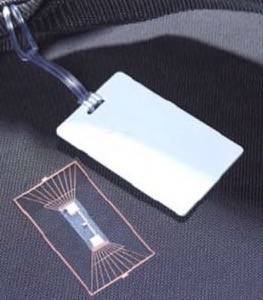In this latest installment of our ongoing series on the Internet of Things, we look at one of the big advantages of Internet-connected objects: trackability. In other words, knowing precisely where an object is at all times – and even better, its condition. This is important particularly for goods that are perishable, such as food. We recently wrote about IBM’s RFID and sensor solutions to track food and horticultural goods.

But tracking objects via the Internet has got very practical uses too for consumers. I can’t think of a better example than the recent case of my lost luggage.
The Ed’s Red Suitcase
Earlier this year I traveled back from Boston to my home in Wellington, New Zealand. I was traveling on two different airlines, from Boston – Los Angeles on American Airlines, then from Los Angeles to Wellington (by way of Auckland) on my preferred airline Air New Zealand.

I arrived at Boston airport one overcast summer morning in late June, entered a disorganized American Airlines queue and walked up to the counter. After a few minutes of being ignored, I managed to wave down a harried-looking staff member. After processing my credit card (twice) for a luggage charge and an extra airfare I had to pay, she grumpily processed my boarding pass. Before I knew it, a boarding pass and luggage ticket had been thrust my way and she’d hastily wrapped a destination label onto my red suitcase. While I checked the boarding pass, a surly looking American Airlines baggage handler hurled my suitcase – upside down – onto the luggage conveyer belt. I got distracted by the rough manner in which my suitcase was thrown, so I neglected to check my luggage ticket…
It was only when I landed in Los Angeles and failed to see my trusty red suitcase appear, that I thought to check my luggage ticket. Dismayed, I discovered that it had the name of another person written on it and was labeled destination Chicago! Cursing, I made my way to the American Airlines lost luggage counter in that part of LAX and filed a claim.
RFID-tagged luggage from FKI Logistex (sadly not on my red suitcase!)

I’ll spare you the rest of my experiences with American Airlines customer service reps (one of whom hung up on me, after I’d phoned them from NZ), but suffice to say that it was a long, frustrating process to get my luggage back. What’s more, this was my second U.S. trip in a row in which my luggage had been lost! (the first time was Air NZ’s fault, it must be said)
Where Are Those RFID Tags?
The point of that anecdote is that my poor red suitcase had no means of being tracked precisely, as it made its way on various planes back to my home in Wellington – or so I hoped at the time. American Airlines certainly didn’t know where my luggage was, all they could tell me was that it was “probably” on a plane to Australia (they wouldn’t tell me which one) and “hopefully” it would turn up soon.

Of course, had my suitcase had an RFID tag, American Airlines – and more importantly I – would’ve have known where it was at all times. I discovered later that it had been put on a plane from Chicago to LA, and from there to Melbourne, and eventually to Wellington (possibly via Auckland). I breathed a big sigh of relief when a courier eventually delivered the battered luggage to my door, but was left wondering when RFID tags would come to the airline industry and make all of our lives easier.
11% of Airlines Now Use RFID
A number of airlines are, to their credit, working on RFID solutions to reduce incidences of lost luggage for their customers. However, as we noted in our previous post on RFID, implementing these solutions is easier said than done.
A recent article from Airport Business (aside: I do love niche news websites!) stated that RFID was first deployed in 2005 at Hong Kong, Milan Malpensa and Las Vegas McCarran airports. It’s shown “great potential,” according to Airport Business, “with a read rate of over 97% compared with around 80% for conventional bar codes.”
RFID is continuing to be deployed at airports, for example United Airlines did a trial earlier this year. According to SITA, 11 percent of airlines now use RFID; up from 2 percent in 2007.
However, airports are experiencing the dreaded implementation issues. Lorne Riley from IATA (International Air Transport Association) told Airport Business that “the wide range of RFID tags means that a prospective user [i.e. the airport] has to make several decisions – should the tag be passive, active or semi-active, what memory size should there be, what air protocol should be used and should the information be encrypted?” To address this issue, the IATA has set up a task force to develop an international standard for RFID baggage tags.

A company called FKI Logistex (which also designed a material handling system for online shoe retailer Zappos, recently acquired by Amazon) is one of the leaders in creating RFID solutions for airports. Recently it launched the industry’s first combined RFID and barcode unit.
The reality is it will take a “coordinated effort,” to use Lorne Riley’s words, to get RFID widely implemented at airports around the world. The main players are airlines, RFID providers and the IATA (with its proposed standard). The main winners will of course be the customers! Although according to a 2008 baggage report by SITA, the aviation industry lost 12.4 billion in 2007 as a result of mishandled baggage. So clearly airlines, and insurance companies too, can make a big cost savings by investing in RFID technology on luggage.
Bring it on, please. I don’t want to lose my luggage for the third time in a row on my next trip to the U.S.
Image credits: M.V. Jantzen; kkennedy

















